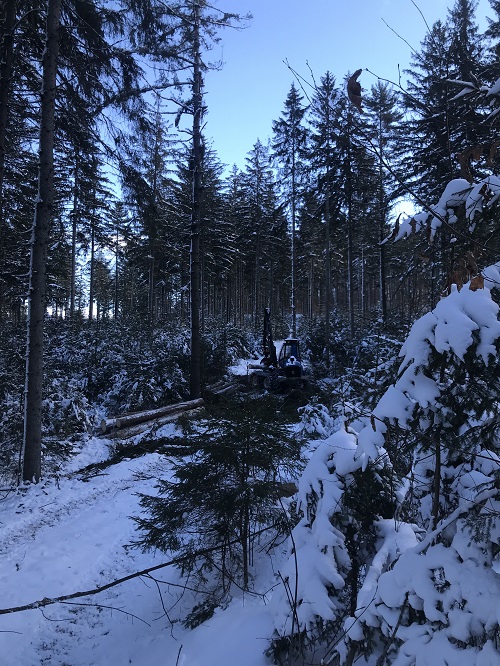The Department of Forests, Parks and Recreation manages publicly owned State Forests and Park lands to promote and protect the natural, productive, and recreational values of these lands and provide for multiple uses of the lands in the public interest. In addition, FPR collaborates with the Fish and Wildlife Department (FWD) to help them meet their habitat management objectives in Wildlife Management Areas. FPR’s forest management oversight is outlined in Vermont Statute, especially 10 V.S.A. §2601 and 10 V.S.A. §2603, and is led by State of Vermont licensed State Lands Foresters practicing modern, sustainable forestry in line with Vermont’s Forest Action Plan.
Why Timber Harvests
 Our approach to management is comprehensive and focused on the future growth and health of our forests. Managing forests and trees requires many different approaches, from attention to a few individual trees or invasive plants to actions that affect larger stands of trees. Timber harvests are one of many tools for achieving these outcomes, and we typically operate several timber sales every year averaging around 1,000 acres a year (0.26% of the Agency’s land base).
Our approach to management is comprehensive and focused on the future growth and health of our forests. Managing forests and trees requires many different approaches, from attention to a few individual trees or invasive plants to actions that affect larger stands of trees. Timber harvests are one of many tools for achieving these outcomes, and we typically operate several timber sales every year averaging around 1,000 acres a year (0.26% of the Agency’s land base).
Timber harvests based on science and good silviculture can enhance wildlife habitat, forest health and resilience, biodiversity, and climate mitigation. For example, a harvest in a stand where all the trees are the same age can create a more diverse mix of tree ages and species that support a greater number of bird species. Prior to any activities affecting trees and the forest, we carefully consider all potential impacts and incorporate input from experts at the Agency of Natural Resources through our long-range management planning process and District Stewardship Team involvement and review.
Among the many considerations, our priorities in developing timber harvests include:
- Water quality: Protecting surface waters and aquatic habitat, vernal pools, and wetlands.
- Habitat protection and improvement: Conserving terrestrial wildlife habitat, biodiversity, and threatened and endangered species.
- Forest health: Ensuring the long-term vitality of forest and soil health.
- Forest products: Providing a range of products from high quality boards to wood heating fuel
- Regulatory alignment: Adherence to regulations and various guidance documents to maintain high-quality standards.
- Climate mitigation: Employing proactive strategies to mitigate and adapt to climate change.
- Historic preservation: Ensuring the preservation of historic and cultural sites within our managed areas.
- Recreational uses: Minimizing potential disruptions during harvesting.
Timber Harvest Process
To ensure the best outcomes and operations, an independent contractor selected through a competitive public bid process, in compliance with Agency of Administration Bulletin 3.5, carries out timber harvests. We prioritize transparency and fairness by clearly defining sale boundaries, trees for harvest, and harvesting guidelines and requiring attendance at a Bid Showing for all bidders. A State Lands Forester licensed by the State of Vermont oversees a timber harvest from planning and contractor selection to monitoring and closeout.
Timber Harvest Showing and Bidding Arrangements
All trees to be harvested are identified prior to a timber sale. A showing date is set and prospective bidders are informed, providing them with the showing and bid due dates, along with a prospectus and sale map. Bids are opened and documented, and the highest qualified bidder is selected.
Contractual Obligations
The winning bidder enters a Timber Sale Contract with the State. This contract includes:
- Details of the timber sold, the price bid, and the contract period.
- Specifications for cutting, utilization, and scaling of trees.
- Felling, skidding and other operational restrictions related to harvesting and trucking.
- Specifications for additional actions required to meet the long-term goals of the harvest.
- Requirements for site restoration and post-sale condition.
- Insurance, safety, and indemnification clauses.
- Payment terms and a required performance bond.
- Any other additional requirements or sale-specific restrictions.
Harvest Monitoring
We ensure contractor responsibility throughout the process by conducting regular inspections of operations and site conditions, monitoring legal compliance by the contractor, and reconciling volumes and payments at the end of the sale.
All trees designated for harvest must be cut and used according to contract specifications. The performance bond from the contractors is held by the State, ensuring contract compliance and site restoration upon completion.
Use of Timber Sale Revenues
When a timber sale leads to payments to the State, those dollars are used to reinvest in publicly owned land for a range of purposes. Some recent uses of these funds include:
- Promoting food source trees for wildlife in Densmore Hill WMA
- Road graveling and culvert maintenance in Camel’s Hump State Park
- Rehabilitating steps on the historic Bald Mountain fire tower
- Construction of a universally accessible trail at Little River State Park
- Treating invasive plants at Alburgh Dunes State Park
Wood Warms
Wood Warms is an initiative operated by the Department of Forests, Parks, and Recreation, aiming to bridge the gap for those facing financial constraints regarding keeping their homes warm. By harnessing the potential of timber harvesting on state-owned lands, this program addresses the need for a sustainably produced and affordable source of firewood. Learn More on the Wood Warms Page.
